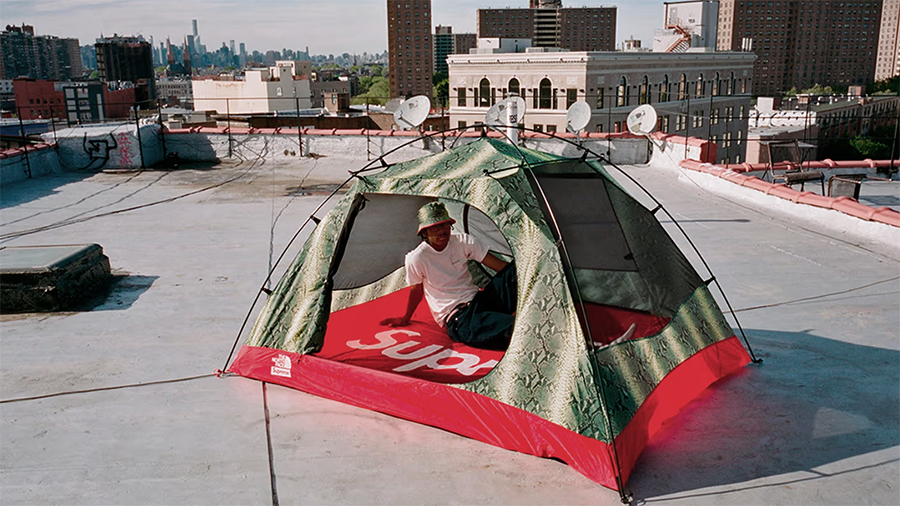It turns out that Prime Day wasn’t the biggest sales event of the week. The much anticipated VF divesture of the Supreme business garnered considerable conversation on the upside and downside of the company’s move to clear the VF brand portfolio of everything that does not fit neatly into the VF corporate infrastructure or create enough exploitable synergies.
SGB Executive compiled input from notes produced by a range of Wall Street sell-side analysts to get a feel for how they view the deal and measure if the Street’s perspectives are fairly universal.
Hint: They were not.
If you were out with COVID or immersed in a major political party convention this week, you may have missed the news on Wednesday, July 17, that beleaguered VF Corp., home to The North Face, Vans, Timberland, Dickies, Jansport and a host of other outdoor and active lifestyle brands, cut a deal with eyewear powerhouse EssilorLuxottica, the owner of the Oakley, Ray-Ban and Native Eyewear brands, and the owner or licensee of a multitude of fashion brands, to sell the Supreme brand.
The two companies entered into a definitive agreement for EssilorLuxottica to acquire the Supreme brand from VF for $1.5 billion in cash. The price tag raised a few eyebrows, although not as many as VF did in December 2020 when it agreed to acquire the Supreme business for a staggering $2.1 billion.
At the center of the concerns at the time was the debt the company took on to fund the transaction using some proceeds from senior notes it issued in April 2020, along with commercial paper borrowings. The bigger questions seemed to come from EssilorLuxottica investors and Supreme fans, who wondered aloud how the brand would survive and grow inside an eyewear conglomerate.
Supreme contributed $538 million of revenue and $166 million in operating income during VF’s 2024 fiscal year but also recorded goodwill and intangible asset impairment charges of $394.1 million and $340.9 million, respectively, in the fiscal year ended March 2023 related to the Supreme reporting unit.
VFC shares surged 13.6 percent to close at $16.15 on July 17. Shares were down slightly on July 18 to close at $16.03.
Stifel and Managing Director Jim Duffy said the rationale for the deal is to “eliminate debt and drive long-term growth for the remaining portfolio, recognizing minimal synergies between the VFC and Supreme businesses.”
Using trailing figures in its analysis, Stifel estimated that the $1.5 billion deal represents 2.8x EV/S (enterprise value to sales) and 11.8x EV/EBITDA (enterprise value to earnings before interest, taxes, depreciation and amortization). The original $2.1 billion purchase price in 2020 represented an EV/EBITDA of just under 15x at the time.
“While we view the realized price as unfavorable relative to underlying value, the Supreme divestiture drives meaningful progress to balance sheet deleveraging,” explained the Stifel team. “Meaningfully, we believe the $1.5bn proceeds provide sufficient cash to eliminate the $1bn Term Loan due in December (F3Q25) and the $750mn 2.4% Senior Notes due April 2025 (F1Q26).”
The note said that, on a pro forma basis, Stifel measured net leverage post-deal close to 3.4x exiting FY25 and 2.3x exiting FY26, which provides significant relief from the company’s prior published estimates of 4.3x in FY25 and 3.1x in FY26.
“We note Supreme represents a single chunky asset sale that benefits the capital structure. Additional asset sales remain possible, implying further opportunity to reduce leverage,” Stifel noted. The team also said the new lower-revenue, higher-EBIT contribution from the revised brand portfolio leaves the go-forward VFC portfolio with more revenue but less profit than previously contemplated.
“Our sum-of-the-parts analysis validates a $19 TP [target price] contemplating Supreme proceeds, fair value assessments of each remaining brand in the portfolio, partially offset by the lost contribution from Supreme,” the firm’s note suggested. Stifel has a BUY rating on VFC shares.
Baird and Senior Research Analyst Jonathan Komp said they maintained their NEUTRAL rating on VFC shares and viewed Supreme transaction and related balance sheet deleveraging positively. Baird also said it viewed the planned debt paydown and re-focusing of internal resources behind existing brand favorably for VFC’s equity value.
“With this move, we expect investor focus to remain split both on potential additional asset sales and ongoing operating challenges for the core portfolio, which are limiting broader financial visibility,” the July 17 note read.
“We are pleased to see VFC’s commitment to repair the balance sheet and to re-focus toward core growth brands, despite the near-term EPS dilution,” the note reads. “Still, with limited visibility to fundamentals across the key remaining brands (FQ1 revenue seen -double-digits), we recommend staying patient since we think a combination of reduced balance sheet risks and stabilization/improvement for VFC’s key brands may be needed to support a sustained improvement in sentiment.”
Baird said its $13 price target is based on ~11.5X NTM EV/EBITDA, which is toward the lower end (9-30X) of VFC’s 10-year range, balancing Baird’s confidence for VFC’s business model to support a higher growth/return profile with negative near-term sentiment and current balance sheet constraints.
Williams Trading and Equity Analyst Sam Poser sees the sale of Supreme as a good start, but it won’t magically erase the issues inherent in the other brands in the VF portfolio.
“The sale of Supreme, while positive, does not magically improve Vans, The North Face (TNF), Timberland (TBL), Dickies, or any of VFC’s other businesses,” Poser wrote in a July 17 note. “The good news is that [the] sale of Supreme will not negatively impact VFC’s leverage with suppliers and factories. The sale of Supreme will reduce VFC’s debt load and the attached interest expense, but net debt will likely remain well over $3.5B at the end of FY25, vs. ~$5.3B at the end of FY24.”
Willams raised its FY25 estimate to 27 cents a share from 17 cents a share and its FY26 EPS estimates to 74 cents a share from its earlier estimate of 50 cents a share. They also raised their price target to $10 from the previous $6 PT.
“Sales in the Americas across the board are likely to remain a significant headwind throughout FY25,” Poser noted. “Positive inflections for Vans and Dickies are still beyond the Horizon. We remain fearful that VFC will force wholesale sell-in to wholesale accounts for brands that are performing well in certain markets. For example, we expect that sell-in for TNF and TBL will be forced in China, where the brands performed well in 4Q24.”
Poser said they are especially concerned that a potential turnaround of Vans will be forced.
“Vans’ newly announced ‘Always Pushing’ ‘storytelling‘ campaign (see SGB Media coverage here), intended to reflect pushing ‘the limits in pursuit of progression,’ would likely mean that Vans’ management will attempt [to] push its product into its wholesale accounts. At this point, based on our checks, there is no indication that retailers are prepared to step up with Vans.“
Williams is maintaining its SELL rating on VFC shares.
Citi and Managing Director Paul Lejuez had the most positive response to the sale of Supreme, upgrading VFC shares from NEUTRAL to BUY.
“The announcement of the sale of Supreme for $1.5BN (more than we expected) has cleared the way for the company to repay both of their upcoming debt maturities,“ Citi wrote in its note. “With the balance sheet weight lifted, we believe CEO Bracken Darrell can focus on improving the rest of the business and will now have more flexibility to make the right strategic moves for the biz. We believe Vans is getting closer to bottoming out, and with a new brand president, any glimmer of good news would likely be positive for the stock.”
The company expects TNF to remain relatively healthy after several quarters of weather-related weakness.
“A 5% FCF [free cash flow] yield (even in a very weak 2025E) provides some downside protection, and we view the risk/reward as favorable for this (now) idiosyncratic self-help sales and margin recovery story with a cleaner balance sheet,“ the team wrote.
Citi said it adjusted its estimates to reflect the Supreme sale, debt paydown, and a more optimistic view of the business, which is tied to having the balance sheet weight lifted.
“Our F25E/F26E go from $0.58/0.93 to $0.53/1.01. Our TP of $20 (from $11) is based on our DCF [discounted cash flow] analysis, using a terminal multiple of 9x and reflects EV/EBITDA of 12x on our F26E. We also back our DCF with a sum-of-the-parts analysis,“ the note concluded.
It appears that the sale of Supreme is seen as a positive (at least at this table of four), but there are still some concerns about the status of other brands in the portfolio. Is the weakness at TNF a mirage and just a seasonal issue? Or is it a trend line that could follow Vans down the rabbit hole? Has Vans really bottomed out? How long will it take Sun Choe to get up and running? And will Vans embracing the Off The Wall messaging play well with the core even as the brand is marketing heavily around Paris runway shows and elite Hollywood influencer types? What is the message here?
As SGB Executive noted in the article below, the company’s most recent 10-K filing with the SEC may indicate the effects of impairment testing, and the resulting goodwill and intangible asset impairment charges for the Timberland, Dickies and Smartwool brands may point to the next businesses slated for the selling block. Time will tell.
Image courtesy Supreme
***
See additional SGB Media coverage of VF Corporation below.
EXEC: VF Corp. Divests Supreme Brand to Oakley Parent in Cash Deal
















